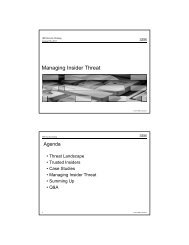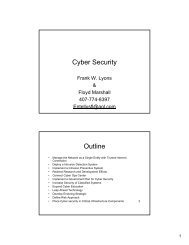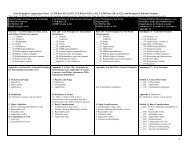Advisory Committee on Tax Exempt and Government Entities (ACT ...
Advisory Committee on Tax Exempt and Government Entities (ACT ...
Advisory Committee on Tax Exempt and Government Entities (ACT ...
You also want an ePaper? Increase the reach of your titles
YUMPU automatically turns print PDFs into web optimized ePapers that Google loves.
Employee Cell Ph<strong>on</strong>es Page 1 of 1Employee Cell Ph<strong>on</strong>es<strong>Government</strong> employers frequently provide their employees with cellular teleph<strong>on</strong>es <strong>and</strong>pagers to employees to c<strong>on</strong>duct business. This can raise special tax c<strong>on</strong>cerns, due to the factthat these items are listed property under the Internal Revenue Code, <strong>and</strong> becauseemployees may use them for business as well as pers<strong>on</strong>al use.What is Listed Property?"Listed property" includes items obtained for use in a business but designated by the InternalRevenue Code as lending themselves easily to pers<strong>on</strong>al use. This includes automobiles,computers, <strong>and</strong> entertainment or recreati<strong>on</strong>-related items. In 1989,cellular teleph<strong>on</strong>es wereadded to this category. Although the use of these ph<strong>on</strong>es IS much more widespread <strong>and</strong>ec<strong>on</strong>omical today, they remain listed property <strong>and</strong> are subject to these restricti<strong>on</strong>s.For a for-profit business, the designati<strong>on</strong> of an item as listed property has implicati<strong>on</strong>s fordepreciati<strong>on</strong> deducti<strong>on</strong>s taken by the business <strong>and</strong> the computati<strong>on</strong> of net income. However,this article focuses <strong>on</strong> the employment tax issues raised for employees of governmententities.Substantiati<strong>on</strong> RequirementsTo be able to exclude the use by an employee from taxable income from an employer-ownedcell ph<strong>on</strong>e, the employer must have some method to require the employee to keep rewrdsthat distinguish business from pers<strong>on</strong>al ph<strong>on</strong>e charges. If the teleph<strong>on</strong>e is used exclusivelyfor business, all use is excludable from income (as a working c<strong>on</strong>diti<strong>on</strong> fringe benefit). Theamount that represents pers<strong>on</strong>al use is included in the wages of the employee. This includesindividual pers<strong>on</strong>al calls, as well as a pro rata share of m<strong>on</strong>thly service charges.In general, this means that unless the employer has a policy requiring employees to keeprecords, or the employee does not keep records, thevalue of the use of the ph<strong>on</strong>e will beincome to the employee.At a minimum, the employee should keep a record of each call <strong>and</strong> its business purpose. Ifcalls are itemized <strong>on</strong> a m<strong>on</strong>thly statement, they should be identifiable as pers<strong>on</strong>al orbusiness, <strong>and</strong> the employee should retain any supporting evidence of the business calls. Thisinformati<strong>on</strong> should be submitted to the employer, who must maintain these records to supportthe exclusi<strong>on</strong> of the ph<strong>on</strong>e use from the employee's wages.The following situati<strong>on</strong>s illustrate the applicati<strong>on</strong> of the rules:Example 1: A municipal government provides an employee a cell ph<strong>on</strong>e for businesspurposes. The government's written policy prohibits pers<strong>on</strong>al use of the ph<strong>on</strong>e. Thegovernment routinely audits the employee's ph<strong>on</strong>e billings to c<strong>on</strong>firm that pers<strong>on</strong>al calls werenot made. No pers<strong>on</strong>al calls were actually made by the employee. The business use of theph<strong>on</strong>e is not taxable to the employee.Example 2. A municipal government provides an employee a cell ph<strong>on</strong>e for businesspurposes. The government's written policy prohibits pers<strong>on</strong>al use of the ph<strong>on</strong>e. However, thegovernment does not audit ph<strong>on</strong>e use to verify exclusive business use. The fair market valueof the ph<strong>on</strong>e, plus each m<strong>on</strong>thly service charge <strong>and</strong> any individual call charges are taxableincome to the employee, reportable <strong>on</strong> Form W-2.Example 3: A state agency provides an employee with a cell ph<strong>on</strong>e <strong>and</strong> pays the m<strong>on</strong>thlyservice charge. The employee is required to highlight pers<strong>on</strong>al calls <strong>on</strong> the m<strong>on</strong>thly bill. Theemployee is then required to timely reimburse the agency for the cost of the pers<strong>on</strong>al calls,<strong>and</strong> the employee is charged a pro rata share of the m<strong>on</strong>thly charge. The value of thebusiness use porti<strong>on</strong> of the ph<strong>on</strong>e is not taxable to the employeeEmployee-Owned Teleph<strong>on</strong>esIf the employee owns the ph<strong>on</strong>e, the listed property requirements do not apply. Any amountsthe employer reimburses the employee for business use of the employee's own ph<strong>on</strong>e mayoe excludable from wages ~f the employee accounts for the expense under the accountableplan rules See ? ~~ii;~t <strong>on</strong> 15 Employer's <strong>Tax</strong> Gu~de (Circular E), for more lnformatl<strong>on</strong> aboutthe accountable plan rules.













